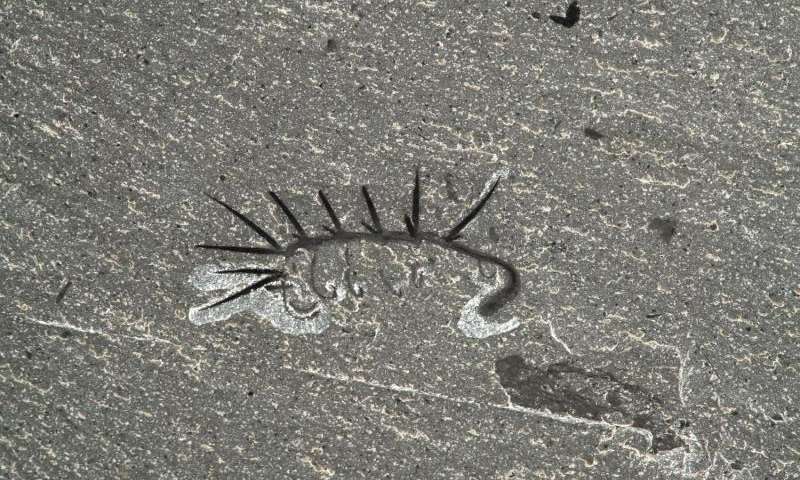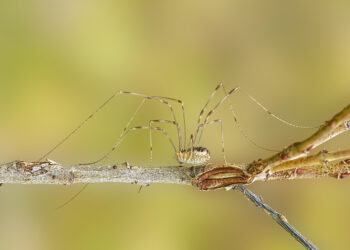When the freakish Hallucigenia was first discovered in the 1970s, paleontologists found it nearly impossible to distinguish head from tail. Now, the bizarre creature – an ancestor to molding animals like crabs, worms or krill – had its features identified with unprecedented precision, but that doesn’t mean it’s less freakish looking: worm-like with a mouth adorned with a ring of teeth, bearing seven pairs of legs ending in claws, and three pairs of tentacles along its neck. To finish it off, its back was covered with enormous spikes. Yes, it looks weird, but so were most animals that lived 500 million years ago during the so-called Cambrian explosion – a period of massive bloom in terms of diversity of life and evolution. Most creatures of those times were somewhat primitive, but remarkably, Hallucigenia was quite advanced for its age.

The fossil remains first discovered in Canada’s Burgess Shale are highly difficult to interpret. Basically, if you look at it in 2D it all looks like a worm with legs or spikes – hard to tell which is which. It’s no wonder that scientists initially described the creature totally upside down: the spines on the back were thought to be legs and vice-versa, and the head was mistaken for a tail. Using electron scan microscopy, researchers at University of Cambridge, the Royal Ontario Museum and the University of Toronto imaged the ancient Hallucigenia with unprecedented precision, casting aside ambiguities.
“Prior to our study there was still some uncertainty as to which end of the animal represented the head, and which the tail,” saidDr Martin Smith, a postdoctoral researcher in Cambridge’s Department of Earth Sciences, and the paper’s lead author. “A large balloon-like orb at one end of the specimen was originally thought to be the head, but we can now demonstrate that this actually wasn’t part of the body at all, but a dark stain representing decay fluids or gut contents that oozed out as the animal was flattened during burial.”
After they realized which end is which, Smith was prompted to revisit the fossils and dig up the sediments around the head of the fossilized creature. This revealed some interesting clues related to its last moments alive. Apparently, this particular specimen was buried in a mudslide.
“This let us get the new images of the head,” said Caron. “When we put the fossils in the electron microscope, we were initially hoping that we might find eyes, and were astonished when we also found the teeth smiling back at us!”

Adorable and nightmarish-looking at the same time, Hallucigenia measured between 10 and 50 millimetres long and its head bore a simple pair of eyes and a row of needle-like teeth. The right of teeth likely helped the animal generate suction, flexing in and out, like a valve or a plunger, in order to suck its food into its throat, as reported in Nature.
“These teeth resemble those we see in many early moulting animals, suggesting that a tooth-lined throat was present in a common ancestor,” said Caron. “So where previously there was little reason to think that arthropod mouths had much in common with the mouths of animals such as penis worms, Hallucigenia tells us that arthropods and velvet worms did ancestrally have round-the-mouth plates and down-the-throat teeth – they just lost or simplified them later.”
Hallucigenia belongs to a group called ecdysozoans, which includes velvet worms (onychophorans) and water bears (tardigrades). While Hallucigenia isn’t the ancestor to all ecdysozoans, it is definitely high up the evolutionary tree and direct precursor to velvet worms. In fact, the findings helped the researchers assert that velvet worms initially had the same configuration, but lost it in time due to evolutionary mechanisms. Smith and Javier Ortega-Hernandez published a paper last year that reported five key characteristics that link the species to the velvet worms.
“The early evolutionary history of this huge group is pretty much uncharted,” said Smith. “While we know that the animals in this group are united by the fact that they moult, we haven’t been able to find many physical characteristics that unite them.”
“It turns out that the ancestors of moulting animals were much more anatomically advanced than we ever could have imagined: ring-like, plate-bearing worms with an armoured throat and a mouth surrounded by spines,” said Dr Jean-Bernard Caron, Curator of Invertebrate Palaeontology at the Royal Ontario Museum and Associate Professor in the Departments of Earth Sciences and Ecology & Evolutionary Biology at the University of Toronto. “We previously thought that neither velvet worms nor their ancestors had teeth. But Hallucigenia tells us that actually, velvet worm ancestors had them, and living forms just lost their teeth over time.”






